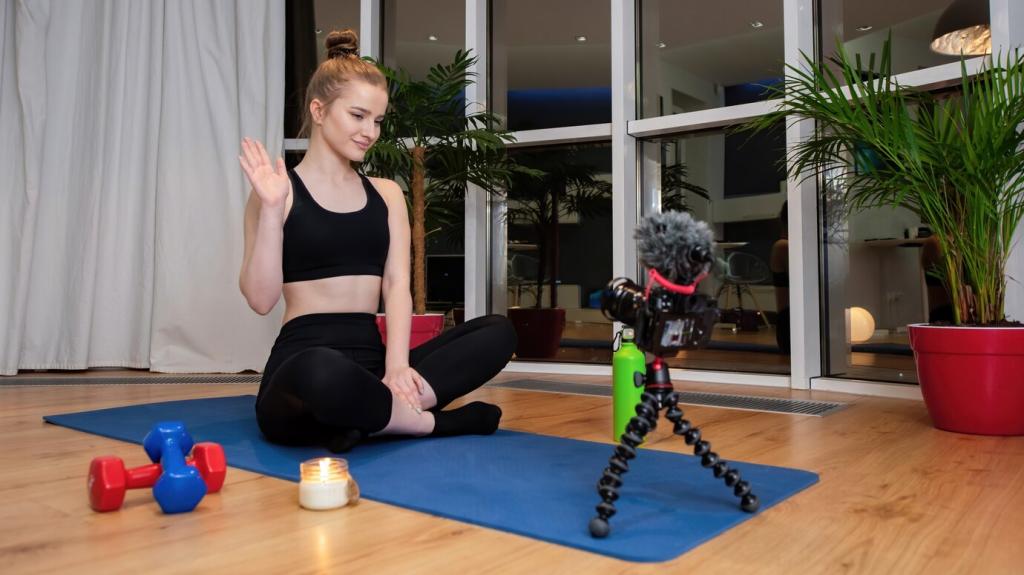
Stronger After Setbacks: Adapting Fitness Plans for Injury Recovery
Chosen theme: Adapting Fitness Plans for Injury Recovery. Welcome to a hopeful, practical space where we transform injuries into learning curves, rebuild confidence with smart progressions, and prove that healing can elevate your fitness story. Subscribe, share your journey, and grow with us.
Listen First: Your Body and Your Clinician as Co-Coaches
Use a color-coded approach to guide workouts during recovery. Green means no symptoms during or after; yellow means tolerable, fading discomfort; red indicates pain that lingers or worsens. Track responses daily and adjust intensity swiftly to protect progress.
Ask your clinician for explicit tolerances—load, range, and frequency. Translate “avoid deep knee flexion” into box squats and split squats with reduced depth. Convert “isometrics daily” into timed holds between sets. Clarify what to do, not just what to avoid.
After a calf strain, Maya swapped tempo runs for pool running and incline hiking. By respecting mild tightness while avoiding sharp pain, she returned to 5K racing stronger, with better cadence, and a new appreciation for strength work and mobility.



Smart Progression: Principles That Protect Healing
Increase training load gradually, but let symptoms set the ceiling. Ten percent is a guideline, not a guarantee. Combine objective metrics—volume, intensity, density—with subjective scores like soreness, stiffness, and confidence to pace your comeback responsibly.
Smart Progression: Principles That Protect Healing
Rate sensations during and 24 hours after training. Mild, short-lived discomfort can be acceptable; sharp or escalating pain is not. If symptoms linger beyond a day, reduce volume or range next session. Consistency beats heroics during injury recovery.
Exercise Swaps: Keep Training Without Poking the Injury
Trade heavy conventional deadlifts for trap bar pulls with reduced range, hip thrusts, or single-leg RDLs holding a dowel for feedback. Emphasize neutral spine, bracing, and tempo. Keep accessory work like bird dogs, Pallof presses, and suitcase carries consistent.
Exercise Swaps: Keep Training Without Poking the Injury
Try cycling with higher cadence, deep-water running, or inclined walking before jogging returns. Tweak seat height to reduce flexion stress. Use intervals that challenge heart rate while keeping joint discomfort minimal, and record responses to adjust session length.
Isometrics for Calming Pain
Isometric holds can provide short-term analgesia while building tendon tolerance. Try 5 sets of 45 seconds at moderate effort for problem areas like patellar or Achilles tendons. Use them as warm-ups before dynamic exercises to reduce perceived pain and guard against flare-ups.
Tempo and Range Make the Difference
Control the eccentric phase and limit depth to tolerated zones. A slow 3–4 second descent reduces joint stress while maintaining muscular stimulus. Progress range of motion incrementally, celebrating each degree gained without forcing uncomfortable end positions.
Low Load, High Frequency Wins Early
In early rehabilitation, short daily sessions can outperform infrequent, heavy efforts. Sprinkle micro-workouts—careful mobility, light isometrics, and technique drills—through the day. Accumulated practice builds capacity while keeping fatigue and irritability manageable.
Mindset Matters: Psychology of a Resilient Comeback
You are not your injury. Shift from “I can’t” to “I adapt.” Set process goals—consistency, sleep, and exercise quality—so progress is always within reach. Share your plan with a friend to strengthen commitment during challenging weeks.


Mindset Matters: Psychology of a Resilient Comeback
Celebrate objective and subjective signals: fewer morning aches, smoother stairs, or one extra pain-free rep. Use a simple log to spot trends and trigger smart progressions. Comment with your latest micro-win to encourage others moving through recovery.



Return-to-Play: Testing Readiness with Confidence
01
Clearance and Non-Negotiables
Secure clinician clearance and define red flags. Pain should be minimal, strength near baseline in key movements, and swelling controlled. Ensure daily activities feel normal before adding complex sport tasks or maximal efforts to prevent premature setbacks.
02
Benchmarks That Matter
Pick objective tests: single-leg hop symmetry, controlled push-up tempo sets, or cycling power at a fixed heart rate. Pair numbers with subjective confidence ratings. If either lags, keep practicing progressive drills until both align positively and consistently.
03
Graduated Exposure, Not a Leap
Reintroduce stress stepwise: technique, tempo, partial range, then full range and speed. For runners, alternate jog and walk intervals before continuous runs. For lifters, increase load last. Comment with your next milestone, and subscribe for weekly recovery templates.
